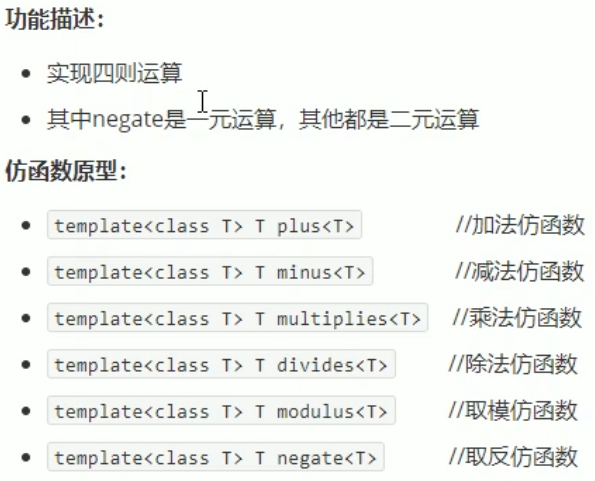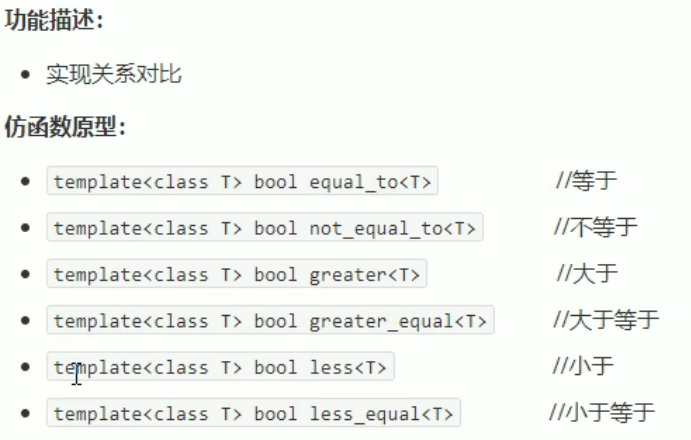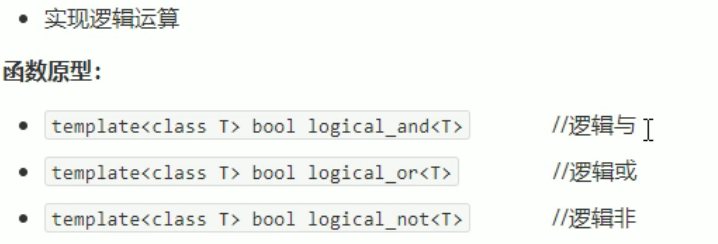4.1 函数对象
概念:
重载函数调用操作符的类,其对象常称为函数对象
函数对象使用重载的(0时,行为类似函数调用,也叫仿函数
本质:
函数对象(仿函数)是一个类,不是一个函数
4.1.1 函数对象使用
特点:
函数对象在使用时,可以像普通函数那样调用,可以有参数,可以有返回值
函数对象超出普通函数的概念,函数对象可以有自己的状态
函数对象可以作为参数传递
1
2
3
4
5
6
7
8
9
10
11
12
13
14
15
16
17
18
19
20
21
22
23
24
25
26
27
28
29
30
31
32
33
34
35
36
| class MyAdd
{
public :
int operator()(int a, int b)
{
return a + b;
}
};
class MyPrint
{
public:
MyPrint():count(0) {};
void operator()(string test)
{
cout << test << endl;
count++;
}
int count;
};
void doPrint(MyPrint& mp, string test)
{
mp(test);
}
void test01()
{
MyAdd myadd;
cout << myadd(10, 10) << endl;
MyPrint myprint;
myprint("hello");
myprint("hello");
myprint("hello");
cout << myprint.count << endl;
doPrint(myprint, "hello");
}
|
4.2 谓词
4.2.1 谓词
概念:
·返回boo类型的仿函数称为谓词
如果operator()接受一个参数,那么叫做一元谓词
如果operator()接受两个参数,那么叫做二元谓词
4.2.2 一元谓词
1
2
3
4
5
6
7
8
9
10
11
12
13
14
15
16
17
18
19
20
21
22
23
24
25
26
27
28
29
| class GreaterFive
{
public:
bool operator()(int val)
{
return val > 5;
}
};
void test02()
{
vector <int>v;
for (int i = 0; i < 10; i++)
{
v.push_back(i);
}
vector <int>::iterator it = find_if(v.begin(), v.end(), GreaterFive());
if (it == v.end())
{
cout << "未找到" << endl;
}
else
{
cout << "zhaodaole" << *it << endl;
}
}
int main()
{
test02();
}
|
4.2.3 二元谓词
1
2
3
4
5
6
7
8
9
10
11
12
13
14
15
16
17
18
19
20
21
22
23
| class MyCompare
{
public:
bool operator()(int a,int b)
{
return a > b;
}
};
void test03()
{
vector <int>v;
for (int i = 0; i < 10; i++)
{
v.push_back(i);
}
sort(v.begin(), v.end(),MyCompare());
for (vector<int>::const_iterator it = v.begin(); it != v.end(); it++)
{
cout << *it << " ";
}
cout << endl;
}
|
4.3 内建函数对象
4.3.1 内建函数对象意义
概念:
STL内建了一些函数对象
分类:
·算术仿函数
关系仿函数
·罗辑仿函数
用法:
这些仿函数所产生的对象,用法和一般函数完全相同
使用内建函数对象,需要引入头文件#include
4.3.2 算术仿函数
 img
img
1
2
3
4
5
6
7
8
| void test04()
{
negate<int>n;
cout << n(50) << endl;
modulus<int>p;
cout << p(10, 20) << endl;
}
|
4.3.关系仿函数
 img
img
1
2
3
4
5
6
7
8
9
10
11
12
13
14
15
16
17
18
19
20
| void test05()
{
vector <int>v;
for (int i = 0; i < 10; i++)
{
v.push_back(i);
}
for (vector<int>::const_iterator it = v.begin(); it != v.end(); it++)
{
cout << *it << " ";
}
cout << endl;
sort(v.begin(), v.end(), greater<int>());
for (vector<int>::const_iterator it = v.begin(); it != v.end(); it++)
{
cout << *it << " ";
}
cout << endl;
}
|
4.3.逻辑仿函数
 img
img
1
2
3
4
5
6
7
8
9
10
11
12
13
14
15
16
17
18
19
20
21
22
23
24
25
| void test06()
{
vector<bool> v;
v.push_back(true);
v.push_back(false);
v.push_back(true);
v.push_back(true);
v.push_back(false);
for (vector<bool>::const_iterator it = v.begin(); it != v.end(); it++)
{
cout << *it << " ";
}
cout << endl;
vector<bool>v2;
v2.resize(v.size());
transform(v.begin(), v.end(), v2.begin(), logical_not<bool>());
for (vector<bool>::const_iterator it = v2.begin(); it != v2.end(); it++)
{
cout << *it << " ";
}
cout << endl;
}
|


